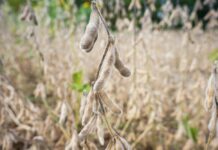
MCCOMB, Ohio — For most people, the day starts with the smell of fresh coffee. For Ohio farmer Anthony Stateler, it starts with something a little stronger.
“We look at manure as a vitamin. It’s like your morning vitamin,” he told attendees during a farm tour on June 9. While most farmers may stick to conventional supplements for themselves, those relying on synthetic fertilizers in their fields are often getting only the basics like nitrogen, phosphorus and potassium, Stateler said.
That means they’re missing out on the full range of nutrients crops need. Manure, by contrast, naturally contains those and more, including valuable micronutrients like sulfur and manganese. His farm, which includes corn, soybeans, wheat and a 7,200-head hog facility, doesn’t have to spend extra money to reap the benefits.
Stateler’s remarks came during the Ohio Agriculture Conservation Initiative’s farm tour, which visited three farms, including Stateler Family Farms, in Hancock County. The tour gave the public a close-up look at how local farmers are using science-based practices to improve both their land and Ohio’s waterways.
One of the major drivers behind this progress is H2Ohio, the state’s water quality initiative that, among other goals, supports environmentally-minded farming practices that won’t sacrifice farm productivity. Much of the Stateler’s tech and equipment upgrades have come thanks to the program, which helps farms spread nutrients more efficiently, reach distant fields and reduce the risk of runoff even during heavy rain.
But the future of that progress isn’t guaranteed. Proposed cuts of more than $120 million to H2Ohio over two years in the Ohio House budget could jeopardize innovation and limit access to these critical tools.
“It will start to hurt a little bit,” Stateler acknowledged. “And quite frankly, it just won’t allow us to maybe be as innovative or to go and find different avenues” for manure application, he said.
Ideas at work
Stateler Family Farms has aimed to bolster innovation from the beginning. Every acre of their 1,000-acre farm has been committed to the Blanchard River Demonstration Farms Network, a 10-year, $2 million initiative now wrapping up after a decade of data and outreach. The project is a collaboration between the U.S. Department of Agriculture’s Natural Resources Conservation Service and the Ohio Farm Bureau. Its goal is to test and share real-world conservation practices that protect soil and water while keeping farms financially sustainable.
The demonstration network was built to highlight not just new ideas, but how those ideas actually work on real farms, under real challenges and offering real results.
“Manure utilization has changed over the years,” Stateler said. His farm reflects just how much. They’ve implemented eight core conservation practices and conduct detailed soil testing before applying any manure. About 60% of that manure stays on the farm’s own fields; the rest is sold to nearby operations, including organic farms.
Using precision ag tools such as GPS-equipped spreaders and detailed field maps, they apply nutrients exactly where they’re needed, avoiding over-application. For every 1% increase in organic matter, the soil can hold about an inch more rainwater, reducing runoff and keeping moisture where crops need it most.
This organic matter, boosted by cover crops and microbial activity, helps retain nutrients and supports healthy crop growth.
Still, Stateler emphasized that most farmers across the state are doing things the right way.
“99% of hog farms are doing no different than what we are,” he said. Rigorous testing and careful nutrient application are becoming the norm, and only a small percentage of fields exceed environmental thresholds.
Even as the formal Blanchard River project comes to an end, Stateler said their commitment to openness and progress remains.
“Just because its ending doesn’t mean that our farm is just gonna shut its doors,” Stateler said.
But the question remains: is it enough? Recent years have seen smaller harmful algae blooms in Lake Erie, which are primarily caused by agricultural runoff, but that’s mostly because there’s been less rain — not because phosphorus pollution has dropped significantly.
Farmers are stepping up, adopting nutrient management plans and science-backed practices through H2Ohio. These plans are a key part of reducing phosphorus runoff. But there’s a catch: without ongoing support, many farms may struggle to keep these practices going.
According to the National Center for Water Quality Research, modeling shows that for real, widespread change, multiple conservation methods need to be implemented at about 70% of farmland in the western basin of Lake Erie. But according to the Ohio Dept. of Agriculture, only 43% have.

“A win-win.”
Bill Kellogg, a farmer managing about 7,000 acres in Forest, Ohio, has witnessed the evolution of conservation practices firsthand. His farm implements a variety of methods supported by the H2Ohio initiative, including strip-till equipment, nearly 70 acres of buffer strips, cover crops and nutrient management planning. Additionally, he employs subsurface phosphorus placement and variable rate technology, which enables precise application of inputs like fertilizer at varying rates across his fields.
Despite logistical challenges — like managing cover crops during busy harvest seasons with limited manpower — Kellogg is pushing ahead. He believes technology is opening up new opportunities once thought impossible.
“What we’re doing now, if you would have told me 50 years ago when my career started, I’d think you were crazy.”
But innovation and commitment can’t stand alone without consistent support. He made it clear that defunding programs like H2Ohio would be a step backward.
“If you’re cutting funding and dragging your money back, it’s not gonna happen,” Kellogg said. “What we’ve done to this point is wasted” without continued support.
Still, he cautioned that funding doesn’t cover everything.
“Anybody in town that thinks that we’re sitting out here getting a check from H2Ohio and we’re making a lot of money on it — it’s just offsetting some of the cost of the things we do,” he said. Being enrolled in H2Ohio is the right thing to do, he said, even if it isn’t always easy or profitable.
“Right now, it’s a win-win,” Kellogg said. “It’s helping us offset some of our costs and it’s helping the environment.” The fear, he added, is that if H2Ohio and federal conservation programs like NRCS lose funding, the progress made over decades could start to erode, and the future of sustainable farming in Ohio could hang in the balance.
For Kellogg, part of the journey has been not just adopting conservation practices, but helping others understand them too. Over the years, he’s had countless conversations with fellow farmers about H2Ohio and what the program really asks of them. Often, they’ll show up with questions, concerns or even frustration.
That’s when Kellogg looks for an opportunity to explain, offer perspective and help them understand how the practices actually work on the ground.
“If you can reason with them,” he told Farm and Dairy, “tell them, ‘Well, it all comes back to checks and balances on what they’re doing,’” then some of the skepticism starts to melt.
It’s not about control, but about accountability and making sure practices actually work for the land, water and the farmer.

“It’s huge.”
Chris Kurt runs a 470-acre farm in Dunkirk, Ohio. He said the H2Ohio program has played a big role in helping him put conservation practices into place — and, to his surprise, they weren’t as difficult as he thought they’d be. Thanks to the program, he’s using tools like variable rate technology to apply phosphorus only where it’s actually needed.
“It helps us only apply the phosphorus where we need it,” he said.
That kind of efficiency has made adopting conservation practices more manageable. Kurt admitted he thought things like strip-till would be a lot more complicated.
“I thought that was gonna be a lot harder,” he told Farm and Dairy. “I thought there was gonna be a lot bigger of a learning curve. It did end up being [not] as bad as I thought.”
Since buying his own strip-till machine wasn’t realistic, Kurt worked with a local fertilizer company to make it work, showing that smaller farms can still take advantage of these methods with the right support.
Kurt is all in on conservation. His entire farm, where he grows corn and soybeans using 11 different practices, is part of the Blanchard River Demonstration Farms Network. For him, the motivation goes beyond his own fields. It’s about being part of a larger effort to learn and share what works.
“I think that’s key. It’s part of the reason I got involved with the Demonstration Farms project in the first place was the fact that they’re doing this research. It’s huge,” he said.
He’s currently trying out lower fertilizer rates on his strip-tilled land to see if the yields can still compete with traditional methods.
With the Blanchard River project wrapping up, Kurt says he’s proud to have been part of it and hopes others have found it useful.
“I’ve been thrilled to be a part of it… My hope is that farmers who have been out to visit the farm and even the general public… get something from it that they can possibly use on their farm.”
But he’s worried that proposed cuts to H2Ohio funding could slow progress.
“I do know this: the less funding you have for farmers to do some of these practices, the less of these practices you’re gonna have,” he said.
Related content
Farmers embrace H2Ohio, but Lake Erie’s algae problem lingers










Thanks for the article. It would be helpful if you would do a followup article on the soil phosphorus levels and the increases or decreased and amounts that changes for manure and commercial fertilizer use with H2Ohio and other conservation practices.